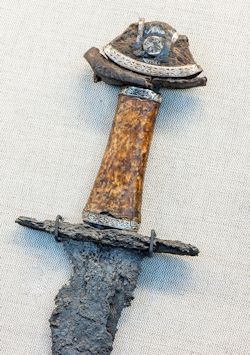
Swords appear relatively frequently in the better equipped male burials in Viking-Age Norway. A small number of these swords, classed as Petersen type L, have been imported from Anglo-Saxon England. They are usually recognised by their triangular pommels with curving guards. In Norway, 18 swords belonging to this group are known, with marked concentrations in the counties of Vestfold and Nord-Trøndelag where 12 of the examples are located (based on information in Petersen 1919, Petersen 1940, Blindheim 1999, and searches in museum databases). The five type L swords from Trøndelag have all been found within the Trondheimsfjord to the north of Trondheim. Such swords generally occur in male burials dated to the 9th century, with occasional examples running into the following century (Petersen 1919).
Several researchers have in recent years highlighted how certain types of swords and other high-status weapons in Norse graves may have marked the buried person's place in society rather than purely reflecting an actual role as warriors or professional soldiers. Swords are likely to have been used as status symbols in all social environments, while the quality of both blade and guard were determined by the owners' social standing and economic capacity (Martens 1994; Andersen 2004). Owing to their small number and distinctive design, it is thought that swords of Petersen type L might have been utilised as particularly strong symbols of power and status among the upper social class in Norse societies (Andersen 2004, 99-100). Traces of gold coating on the hilt of a type L sword from Sundnes, Inderøy, seems to confirm that Anglo-Saxon swords may have had other meanings besides their practical use.
Rare and imported weapons must have been treasured possessions and, therefore, sometimes repaired. A sword from Heggestrøa, Steinkjer, represents an example where the pommel and two silver mounts of a late Anglo-Saxon sword in Trewhiddle style have been reused and added to a new blade in the Viking period (Figure 22). The main ornaments on silver bands attached to the grip consist of a series of contiguous lozenges. In the centre of each lozenge is a minute foliate motif – usually quatrefoil, but occasional bifoliate. The ornaments are reserved against a niello background. A curved silver band above the pommel-guard is decorated in a similar fashion to the bands on the grip. Above this, the iron pommel is tripartite, divided by silver bands, while the centre of the pommel is embellished with a roundel, divided up into eight segments.

The sword is a typical 9th-century weapon and can be compared in its embellishment and in the form of its pommel to two other Anglo-Saxon swords also found in Norway, those from Grønnesberg and Dolven, particular the latter which has lozenge and leaf pattern very similar to that on the Heggestrøa sword (Wilson 1965, 37). In addition to the above examples, only two other Trewhiddle style swords are known nationwide; the ones from Verdal, Larvik and Kaupang, Tjølling. This small assemblage of imported weapons thus appear as a rare and exclusive group among the large number of Viking-Age swords from Norway.
Internet Archaeology is an open access journal based in the Department of Archaeology, University of York. Except where otherwise noted, content from this work may be used under the terms of the Creative Commons Attribution 3.0 (CC BY) Unported licence, which permits unrestricted use, distribution, and reproduction in any medium, provided that attribution to the author(s), the title of the work, the Internet Archaeology journal and the relevant URL/DOI are given.
Terms and Conditions | Legal Statements | Privacy Policy | Cookies Policy | Citing Internet Archaeology
Internet Archaeology content is preserved for the long term with the Archaeology Data Service. Help sustain and support open access publication by donating to our Open Access Archaeology Fund.
File last updated: Wed Dec 3 2014